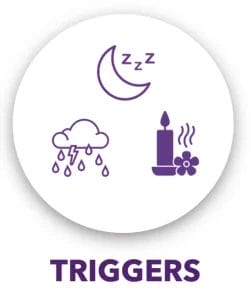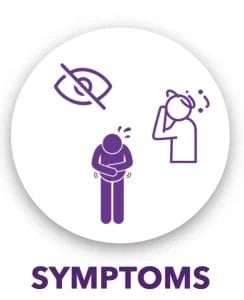Is Every Migraine Attack the Same?
If only managing migraine was a cookie-cutter experience, not only with everyone being the same, but also for each of our migraine attacks! Unfortunately, that is a “dream” that is far distant from reality. Effective and comprehensive migraine treatment means individualized treatment planning, and there are no “one-size-fits-all” recipes. Having multiple treatment options in your migraine toolbox helps you better manage life with migraine, but figuring out how to treat each individual attack takes it one step further. That is where Attack-Based Care comes into the picture! As you are deciding how to treat your migraine attacks, there are a few questions you should ask yourself and your doctor. The answers you come up with, and the information in the coming blogs, will help support you with what you need to develop your attack-based care plan.
Over the next 4 weeks we will be looking at:
- TIMING: How soon are you able to initiate treatment for this migraine attack?
- TRIGGERS: What were the main factors that triggered this migraine attack?
- PAIN LEVEL: What is your pain level with this migraine attack?
- SYMPTOMS: What are your “most bothersome symptoms” for this migraine attack?
How Soon Are You Initiating Treatment?
 Theoretically, we know that a full-blown migraine that wakes us up in the wee hours of the morning is very different from one we are able to catch within the first few minutes, but thinking through how this impacts our treatment plan is a new concept for many of us. So how should we approach attacks based on when we are able to initiate treatment? The reality is that treating an attack at the beginning, the middle, or the end creates very different scenarios. On one end of the spectrum you may be able to utilize more OTC options, medications that take longer to kick in, and medical devices. On the other end of the spectrum, your entire focus is likely to be on STOPPING THE PAIN ASAP and staying out of the ER, and you may need to go directly to a nasal spray or injection.
Theoretically, we know that a full-blown migraine that wakes us up in the wee hours of the morning is very different from one we are able to catch within the first few minutes, but thinking through how this impacts our treatment plan is a new concept for many of us. So how should we approach attacks based on when we are able to initiate treatment? The reality is that treating an attack at the beginning, the middle, or the end creates very different scenarios. On one end of the spectrum you may be able to utilize more OTC options, medications that take longer to kick in, and medical devices. On the other end of the spectrum, your entire focus is likely to be on STOPPING THE PAIN ASAP and staying out of the ER, and you may need to go directly to a nasal spray or injection.
timing icons
What Are the Main Triggers?
 Migraine triggers are a hot topic among people who live with migraine. Figuring them out can be elusive and frustrating, and no two people are exactly the same in their experience. It’s important to try and determine your key attack triggers, but it is also helpful to take that one step further and ask yourself, “Do any of my migraine triggers result in more severe, faster escalating, or more treatment resistant attacks than others?” For example: Menstrual migraine attacks often last longer or are more treatment resistant. Some people find that their top trigger results in attacks that are more severe and which escalate faster. Knowing whether or not this is a factor in your own experience is important because it may impact the treatment tools you utilize.
Migraine triggers are a hot topic among people who live with migraine. Figuring them out can be elusive and frustrating, and no two people are exactly the same in their experience. It’s important to try and determine your key attack triggers, but it is also helpful to take that one step further and ask yourself, “Do any of my migraine triggers result in more severe, faster escalating, or more treatment resistant attacks than others?” For example: Menstrual migraine attacks often last longer or are more treatment resistant. Some people find that their top trigger results in attacks that are more severe and which escalate faster. Knowing whether or not this is a factor in your own experience is important because it may impact the treatment tools you utilize.
migraine trigger icons
What Is Your Current Pain Level?
 Knowing your pain level and how fast abortive treatments work for you can also help determine which treatment, or treatments, to try, and in what order. For example, if you are having a migraine attack that is escalating rapidly, or one that you woke up with and is full-blown, how does treatment for that compare to an attack with a lower pain level? For low pain attacks you may potentially be able to avoid prescription medications, especially if you can lie down in a dark, quiet room and rest. For moderate pain there is the concern that it could escalate, so the decision about treatment options may be more challenging. With severe pain, getting relief as quickly as possible is key, and often injections and nasal sprays are able to get to work much more quickly than medications which go through the GI system.
Knowing your pain level and how fast abortive treatments work for you can also help determine which treatment, or treatments, to try, and in what order. For example, if you are having a migraine attack that is escalating rapidly, or one that you woke up with and is full-blown, how does treatment for that compare to an attack with a lower pain level? For low pain attacks you may potentially be able to avoid prescription medications, especially if you can lie down in a dark, quiet room and rest. For moderate pain there is the concern that it could escalate, so the decision about treatment options may be more challenging. With severe pain, getting relief as quickly as possible is key, and often injections and nasal sprays are able to get to work much more quickly than medications which go through the GI system.
Pain icons
What Are Your Attack Symptoms?
 Some people face a range of symptoms that vary from attack to attack, or even within one attack. Pain, nausea, vomiting, and blurry vision. Confusion, brain fog, unstable motor skills, vertigo, dizziness, and abdominal pain. Over sensitivity to lights, smells or sounds, extreme tiredness, neck and shoulder pain, sinus congestion, teary eyes, and much much more. If you have severe nausea or vomiting, oral medication may even be totally useless and a nasal spray or injection may be more appropriate. If you have vertigo, shaking or vision loss, then you may not be able to open those frustrating foil-sealed tablets that so many companies love to market for a variety of medications. Knowing your symptoms can help you determine appropriate treatment options.
Some people face a range of symptoms that vary from attack to attack, or even within one attack. Pain, nausea, vomiting, and blurry vision. Confusion, brain fog, unstable motor skills, vertigo, dizziness, and abdominal pain. Over sensitivity to lights, smells or sounds, extreme tiredness, neck and shoulder pain, sinus congestion, teary eyes, and much much more. If you have severe nausea or vomiting, oral medication may even be totally useless and a nasal spray or injection may be more appropriate. If you have vertigo, shaking or vision loss, then you may not be able to open those frustrating foil-sealed tablets that so many companies love to market for a variety of medications. Knowing your symptoms can help you determine appropriate treatment options.
Symptom icons
The Migraine Toolbox & Attack-Based Care
Over the next 4 weeks we will be looking at creating an attack-based care plan. The tools you and your doctor select will support you in successfully treating each migraine attack, and provide an easy roadmap to follow when you are in the middle of a migraine and struggling to think clearly. It’s really important for you to know your body, the type of migraine you have, and what symptoms you experience during attacks. Then, talk about it with your doctor and come up with a comprehensive attack-based care plan that works best for you!
Let Us Know
Follow along each week with us for a new topic about attack-based care for migraine, and let us know: How do you treat different migraine attacks, and have you ever talked to your doctor about this?